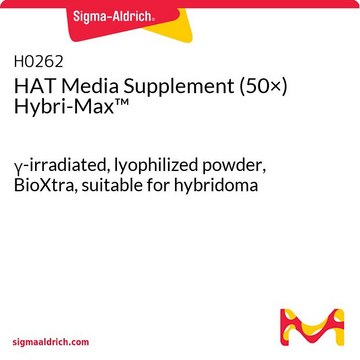10783641001
Roche
Polyethylene Glycol 1500
Mr ~1500, pkg of 10 × 4 mL, solution
Synonym(s):
Poly(ethylene glycol), peg 1500, PEG
Sign Into View Organizational & Contract Pricing
All Photos(1)
About This Item
Recommended Products
form
solution
mol wt
Mr ~1500
packaging
pkg of 10 × 4 mL
manufacturer/tradename
Roche
storage temp.
2-8°C
SMILES string
C(CO)O
InChI
1S/C2H6O2/c3-1-2-4/h3-4H,1-2H2
InChI key
LYCAIKOWRPUZTN-UHFFFAOYSA-N
Looking for similar products? Visit Product Comparison Guide
General description
Poly(ethylene glycol) (PEG) is a non-ionic hydrophilic polymer and is available in different molecular weights. It helps in the purification and crystal growth of proteins and nucleic acids. PEG and dextran together result in aqueous polymer two phase system, which is required for the purification of biological materials. PEG also interacts with cell membrane, thereby allowing cell fusion.
Application
Polyethylene Glycol 1500 (PEG-1500) has been used to mediate cell fusion.
Physical form
Solution, filtered through 0.2 μm pore size membrane, 50% PEG 1500 (w/v) in 75 mM Hepes (pH 8.0), bottled under nitrogen, ready to use
Other Notes
For life science research only. Not for use in diagnostic procedures.
Storage Class Code
12 - Non Combustible Liquids
WGK
WGK 1
Flash Point(F)
does not flash
Flash Point(C)
does not flash
Choose from one of the most recent versions:
Already Own This Product?
Find documentation for the products that you have recently purchased in the Document Library.
Customers Also Viewed
Localization of Pom121 to the inner nuclear membrane is required for an early step of interphase nuclear pore complex assembly.
Funakoshi T, et al.
Molecular Biology of the Cell, 22(7), 1058-1069 (2011)
Usefulness of a non-invasive reporter system for monitoring reprogramming state in pig cells: results of a cell fusion experiment.
Ozawa A, et al.
Journal of Reproduction and Development, 56(4), 363-369 (2010)
Heterokaryon?Based Reprogramming for Pluripotency.
Pereira C F and Fisher A G
Current Protocols in Cell Biology, 4B-1 (2009)
Poly(Ethylene Glycol) Chemistry: Biotechnical and Biomedical Applications (2013)
Poly (ethylene glycol) in drug delivery: pros and cons as well as potential alternatives.
Knop K, et al.
Angewandte Chemie (International Edition in English), 49(36), 6288-6308 (2010)
Our team of scientists has experience in all areas of research including Life Science, Material Science, Chemical Synthesis, Chromatography, Analytical and many others.
Contact Technical Service



